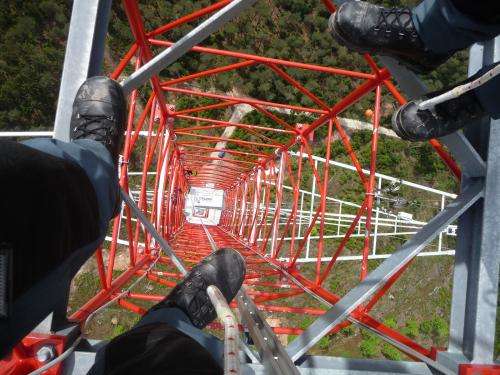More accurate wind energy forecasts

Wind power is one of the most important forms of renewable energy. In order to exploit inland wind as effectively as possible, turbines must be optimally positioned and dimensioned. A 200-meter high wind measuring mast delivers precise data that can also be used to forecast energy yields.
The decision has been taken by the German government to transform the energy system and phase out nuclear energy power. The transition process is gaining impetus but much remains to be done. During the course of which, the production of wind energy is to be dramatically expanded – not only through costly offshore facilities, but onshore as well. "There is still immense potential inland that remains to be tapped, such as in the low mountain ranges," says Tobias Klaas, scientist at the Fraunhofer Institute for Wind Energy and Energy System Technology IWES in Kassel. Klaas is also the head of the "Inland Wind Energy Use" research project sponsored by the German Federal Ministry for the Environment.
To run a wind farm as efficiently as possible, planners must know in advance precisely what wind speeds predominate at the site, and what kind of turbulence is to be expected. The problem: "With conventional methods, it is almost impossible, or possible only at great effort and expense, to measure projected power when planning modern, large-scale facilities," says Klaas. Moreover, forests and hills hamper the analysis of wind conditions. Experts refer to this aspect as "complex terrain," where topography influences wind conditions, even at great heights.
Tallest wind measuring mast in Europe
For these reasons, Klaas and his colleagues at IWES erected a 200 meter wind measuring mast. Since January, on a tree-covered hill not far from Kassel, they have been taking measurements of wind speeds, turbulence and additional meteorological data. It is Europe's tallest measuring mast for wind energy. Conventional masts are only about 100 meters in height. The rotor blade of a modern turbine, however, easily reaches double that height. As astonishing as it may sound: Scientists know little about the dynamics of wind conditions up there. "Indeed, there are theories about how wind speed increases with height, yet these no longer apply at such great heights. Hence, actual measurement values are needed to further develop the models," explains Klaas.
For instance, trees decelerate ground-level winds and create turbulence, and it was previously not possible to draw readily available conclusions about the conditions at the upper regions based on these data. Thanks to the Fraunhofer researchers' measuring mast, this can now be done. Using ultrasound anemometers (special wind gauges), it records, in spatial terms, how fast and in which direction the wind is blowing, thereby rendering a precise depiction of the turbulence. Conventional vane anemometers moreover establish wind speed and direction at various heights. They additionally measure other meteorological factors, like air pressure, humidity and temperature. The figures on precipitation amounts and the duration of sunshine complete the data set. "We have achieved a unique sensory device that allows us to determine the impact of these parameters on wind conditions," says Klaas.
The detailed measurements not only help in the optimal alignment of wind turbines, but also in determining the appropriate dimensions. This is the precondition for ensuring, for example, that the turbines are built at the correct height and designed with no greater mass than necessary, which saves on expenses.
With the aid of the wind measuring mast, it should additionally be possible to develop standards for LIDAR (light detection and ranging), the new ground-based remote measurement process. The laser-optical measurement process is considered the key to wind profile measurements up to heights of several hundred meters. Due to the lack of standards, LIDAR remains unapproved as the sole measurement process for expert reports on wind, which are the basis for yield calculations. If successfully granted one day, thanks to the Fraunhofer measuring mast, then such approval would make expert reports on wind superfluous, because LIDAR would render measuring masts obsolete.
Provided by Fraunhofer-Gesellschaft



















